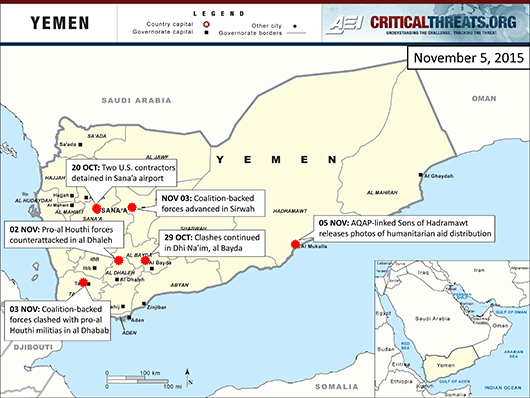The frontlines in Yemen remain fixed even as fighting escalates in buildup to proposed UN-led peace talks. The security conditions are exacerbating the ongoing humanitarian crisis and preserving the security vacuum that is allowing al Qaeda in the Arabian Peninsula (AQAP) to increase its influence throughout Yemen.
The battle for Taiz continues as both pro- and anti-al Houthi forces fail to gain clear momentum. The city itself remains contested. Pro-al Houthi forces shelled strategic anti-al Houthi sites on November 3, including the Cairo Fortress area in southern Taiz city and Mt. Sabir, which overlooks Taiz city from the south. The al Houthis seek to maintain control of Taiz city and its major access points to the south and east. Pro-al Houthi forces attempted to cut off coalition supply lines to the southeast near the Taiz-Lahij border on November 3. They have also restricted humanitarian aid access to Taiz. Positions in northern Taiz remain fixed, and al Houthi-Saleh militias are now applying pressuring on coalition-backed forces in southern Taiz. Pro-al Houthi forces launched a counterattack on November 3 in Dhubab near the Bab al Mandeb coastal region, which coalition-backed forces secured at the beginning of October. Al Houthi and Saleh militias also clashed with anti-al Houthi forces on the al Wazi’iyah-al Madiribah front on Taiz’s southern border with Lahij governorate, an anti-al Houthi and coalition stronghold.
Clashes between anti-al Houthi popular resistance forces and al Houthi-Saleh forces resumed in al Bayda governorate, where AQAP has had a growing presence. Anti-al Houthi forces regrouped after having been pushed south into Abyan governorate in the middle of October, attacking pro-al Houthi militia positions in Dhi Na’im and al Zahar districts in southern al Bayda on October 29 and 30. Pro-al Houthi reinforcements mobilized to the area. An al Houthi sniper killed a member of a prominent anti-al Houthi tribe in al Zahar, which may further mobilize the local population against the al Houthis. The Saudi-led coalition provided air support in southern al Bayda, striking pro-al Houthi targets in Dhi Na’im and Mukayras. AQAP-affiliated militants conducted at least seven attacks on pro-al Houthi targets in al Bayda in the past two weeks. (Sources available upon request.)
Pro-al Houthi militias launched a counteroffensive in al Dhaleh governorate in south-central Yemen, following an anti-al Houthi offensive that secured much of the governorate in June and July. Popular resistance forces stopped al Houthi advances in Damt city, controlling the northern access to the road through the governorate, and mobilized reinforcements to the region on November 1. Pro-al Houthi forces regrouped in al Riyashiyah in neighboring al Bayda on November 2 after failing to advance from Damt. The Dhaleh governor called for popular resistance fighters to unite against the al Houthis in both Damt and Qatabah, central al Dhaleh.
The Ma’rib frontline remains fixed in Sirwah district, west of Ma’rib city. Control over Ma’rib is significant because the governorate houses critical oil infrastructure and borders the al Houthi-held Yemeni capital, Sana’a. Pro-al Houthi militias continued a counterattack on coalition-backed forces near Kawful military base. Coalition-backed forces pushed pro-al Houthi fighters out of Wadi al Wakifah in southeastern Sirwah. Coalition airstrikes targeted al Houthi positions in the region. The UAE is now rotating in a second deployment in Ma’rib.
Yemeni political parties signed a Charter of National Honor against the Saudi-led coalition. Mohammed Ali al Houthi, the chairman of the Supreme Revolutionary Committee in Sana’a, spoke at the signing ceremony. Attendees included representatives from the Haqq and Ummah parties, among others. This show of unity may be intended to limit the influence of the Saudi-led coalition in the upcoming negotiations and safeguard the al Houthis’ interests in a politically negotiated settlement. The presence of foreign coalition troops in Yemen, as well as the coalition’s airstrike campaign, may increase popular support for the al Houthis.
The al Houthis detained two American UN contractors in Sana’a airport, according to reports. If confirmed, there are three Americans in Sana’a, including an American teacher whose release had been planned for September. The al Houthis may use hostages to increase their leverage in the mid-November peace talks.
A Russian plane broke the coalition’s no-fly zone and delivered 23 tons of humanitarian aid to Sana’a. Saudi Brig. Gen. Ahmed Asiri said the flight had received permission from the coalition to land in Sana’a. The plane will also evacuate 75 Russian nationals from the Yemeni capital. The ongoing fighting and Yemen’s humanitarian crisis are providing an opportunity for foreign powers to influence Yemeni stakeholders in the buildup to the UN-led peace talks scheduled for mid-November.
The humanitarian aid response to Cyclone Chapala in AQAP-controlled al Mukalla, Hadramawt may increase AQAP’s legitimacy in the region. International aid groups delivered food, shelter, and medical aid to al Mukalla in collaboration with “de facto local authorities.” Eight people have died during the storm in al Mukalla. A Twitter account linked to the AQAP-affiliated Sons of Hadramawt posted photos of the group’s relief efforts near al Mukalla. Residents in neighboring Shabwah governorate complained of the local pro-Hadi government’s failure to respond to the crisis. (Sources available upon request.)
The frontlines will likely remain relatively fixed because they are now aligned along lines of support within the human terrain. Continued fighting will exacerbate Yemen’s ongoing humanitarian crisis, provide the opportunity for foreign powers to influence the upcoming negotiations, and allow AQAP to increase its operational and governmental capabilities.

